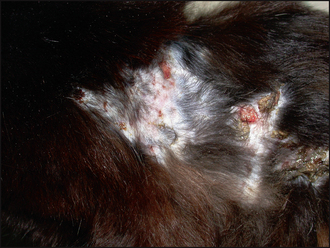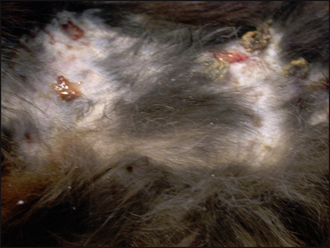47 Feline mycobacterial disease
INTRODUCTION
Non-healing draining wounds and nodules, however, although uncommon, can be a diagnostic and therapeutic challenge. They can be caused by infectious organisms (bacterial, fungal, viral and protozoal organisms), foreign body reactions, sterile panniculitis and neoplasia (Table 47.1). Concurrent infections with FIV, FeLV or corona virus and the use of immunosuppressive drugs may be underlying causes of infection. Identification of the infectious organism is important, as some may have zoonotic implications and others may be life threatening. Cats presented with non-healing abscesses, non-healing wounds, nodules, draining tracts and cellulitis require extensive investigation and treatment.
Table 47.1 Causes for cutaneous nodules and draining tracts in cats
| Bacteria | Non-acid-fast organisms | Actinobacillus spp., Arcanobacterium pyogenes (previously known as Actinomyces pyogenes), Rhodococcus equi, Staphylococcus spp., Streptococcus spp., Pseudomonas spp., Proteus spp. |
| Acid-fast organisms | Norcardia asteroides, Mycobacterium lepraemurium, M. tuberculosis, M. microti, M. chelonei, M. fortuitum, M. phlei, M. thermoresistible, M. smegmatis | |
| Fungi | Subcutaneous mycoses | M. canis, Rhizomucor, Mortierella, Fusarium, Paecilomyces, Alternaria, Cladosporium, Exophiala, Moniliella, Curvularia, Madurella, Pythium insidiosum, Sporothrix schenckii |
| Systemic mycoses | Cryptococcus neoformans, Sporothrix schenckii, Histoplasma capsulatum, Blastomyces dermatidis, Coccidioides immitis | |
| Parasitic or protozoal | Leishmania spp., cutaneous habronemiasis | |
| Viral | Cowpox virus, calcivirus, herpes virus | |
| Non-infectious causes | Foreign body reactions, eosinophilic granulomas, sterile nodular panniculitis, xanthamatosis, cutaneous histiocytosis and neoplasia |
After Patel A (2002): Pyogranulomatous skin disease and cellulitis in a cat caused by Rhodococcus equi. J Small Anim Pract 43, 129–132, with permission of Blackwell Publishing.
CASE HISTORY
In this case the relevant history was:
CLINICAL EXAMINATION
A clinical examination revealed:
Stay updated, free articles. Join our Telegram channel

Full access? Get Clinical Tree




